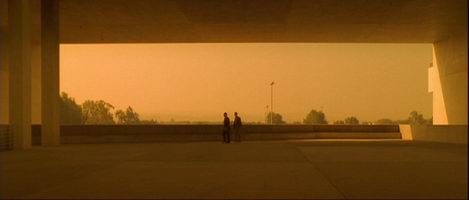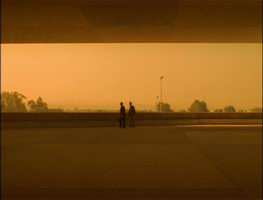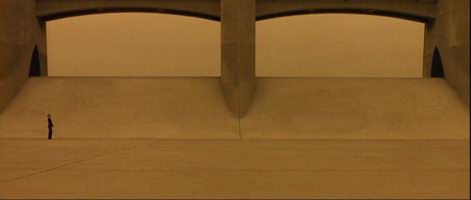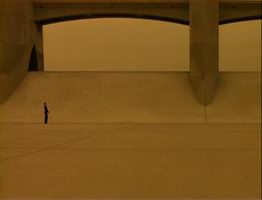A Widescreen Primer
a guide to widescreen on home video for those who can't define
"anamorphic"
Part Two - When is Less Actually More?
Introduction
If you have already read
Part One of this
article, you will be aware of the issues that arise when widescreen film is
transferred for viewing on narrower TVs. Compromises have to be made either to
the original width of the film or to the size of the image on the TV.
The compromise discussed in the preceding article was the Pan & Scan process, a
method by which the width of the widescreen image is sacrificed in order to fill
a narrow TV frame with the remainder of the image.
This is actually an oversimplification of the
issue, as there are two other compromise techniques
commonly used in filmmaking to accommodate the narrower aspect ratio of TVs -
soft matting (full frame transfers) of 1.85:1 movies, and Super 35 photography
of 2.35:1 movies. These are the subject of this
article. Additionally, we will also cover the concept of anamorphic photography,
used for the conventional production of 2.35:1 movies, as you need to understand
this to understand the requirement for Panning & Scanning in certain situations.
1.85:1 Movies can be Panned & Scanned or Open Matted
Pan & Scan
If the intended aspect ratio of a movie is
1.85:1, there are two ways in which the original widescreen image can be
modified for narrow TV screens. One of these is by using the Pan & Scan process
as already
discussed, but the more common process is known as open matting, or full frame
transfers. As a reminder, reproduced below is an example of a 1.85:1 movie that
has been Panned & Scanned.
Panning & Scanning a 1.85:1 film
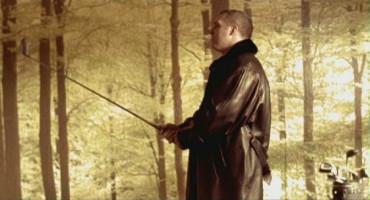 This is a still frame from the 1998 classic Lock, Stock, And Two Smoking
Barrels. The film was originally presented in an aspect ratio of 1.85:1.
Note the bag of golf clubs on the extreme right of the frame near Frank Harper,
and the number of trees in the painting in the background. |
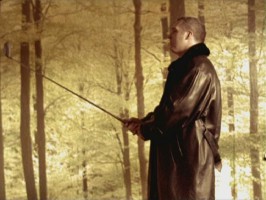 This is the same still frame from Lock, Stock, And Two Smoking Barrels
after having been cropped in order to fit onto a 1.33:1 television screen. The golf bag is
now missing, as are a noticeable number of trees on both sides of the background painting. The
result is a shot that looks and feels much more cramped than in its original form, and is not
what director Guy Ritchie had intended. |
Full Frame (Open Matte)
To fully understand the open matte or full frame
process (and the other processes mentioned later on), you need to realise that most film, all the way from original negative
to final theatrical release print, is actually 1.33:1 wide, regardless of the
final intended aspect ratio of the movie being shot or projected. Movie cameras
and film projectors both take 1.33:1 sized film.
When a 1.85:1 movie
is being shot, extra image is actually captured to that which the director and
cinematographer intend to be shown in the movie theatre. This is usually at the
top and the bottom of the image. When the image is being composed through the
camera, markings on the viewfinder show the director and cinematographer what will actually show up
theatrically, so that important image details are not left out of shot.
When it comes time to show the movie
theatrically, the 1.33:1 print has a masking plate placed in the image path so
that unwanted parts of the image are not shown in the theatre, and instead the
audience sees what the director intended. This process is known as soft
matting.
The key concept here is that there is indeed
extra image available to that which is shown theatrically, and to that
which was intended to be seen artistically by the director and the
cinematographer. This extra image comes in handy when it comes time to transfer
the movie to a TV format, as instead of losing image width, as with the Pan &
Scan process, you can simply remove the mattes to get a 1.33:1 image. Thus,
there is no loss of image, and indeed there is extra image shown.
However, all is not as rosy as it would
appear with this process, as two compromises have been made;
-
The image is no longer in the director and cinematographer's
intended aspect ratio. They composed their images to be seen at this aspect
ratio, and this is compromised by the full frame process, losing artistic
impact as a result.
-
Sometimes unwanted information can be seen in the opened
matte sections of the image, such as boom microphones, camera tracks, and
other things invisible at the theatrical aspect ratio.
A Full Frame Transfer of a 1.85:1 film
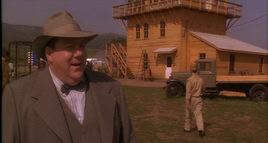 |
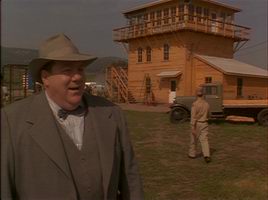 |
| This is a still frame from Forever
Young. This is how the movie appeared in theatres. |
This is the same still frame after the
top and bottom mattes have been removed. Note the extra picture shown at
the top and the bottom of the screen. Note also the different feel of
the images, with the additional information taking the focus away from
the intended subject of the shot. |
2.35:1 Films use Anamorphic Photography
As explained above, most film negative stock
is actually 1.33:1 wide, but this has been adapted to widescreen use. In the
case of 1.85:1 movies, a small amount of image resolution is sacrificed by
simply discarding the top and the bottom of the image. This is not a problem in
practice. However, for 2.35:1 movies, the situation is not as simple. If 2.35:1
movies were made simply by matting the top and the bottom of the image, 50% of
the resolution of the film stock would be lost. By the time this reached the
theatre, the nett result would be a very poor quality image.
This problem has been resolved by the
development of anamorphic photography. The processes involved have
various trade names, but the common ones are Panavison and Cinemascope.
In these processes, a special lens is placed
on the camera which distorts the image. It squeezes images horizontally
by a factor of 2 to 1. The entire film negative is used to capture the image.
The film negative is 1.33:1 wide, but the image captured is actually 2.35:1
wide. If you look at the developed negative, the image appears tall and narrow.
When the film is projected, a complementary lens is used to project the image
which expands the image back to the original 2.35:1. Thus, image quality is
maintained as no area of the negative is wasted.
Films produced using this process must be
Panned & Scanned when they are transferred to a narrow format. There is no
additional picture information available, as the entire camera negative has been
used up capturing the widescreen image.
2.35:1 Films can use the Super 35 Process
The Super 35 process is an attempt to achieve
much the same goals for 2.35:1 films as the open matte process achieves for
1.85:1 movies - an acceptable presentation of a widescreen movie on a narrow TV
screen.
A Super 35 image is photographed onto film
stock which is the same shape as ordinary 1.33:1 film stock, but where the space
normally reserved for audio tracks on the film stock is used for image.
The theatrical release print is made by
matting a little under 1/2 of the original negative and then zooming in on the remaining
image. For narrow TV images, again the image is opened up by removing the matte,
although the sides of the image are also narrowed a little in the process.
A Super 35 Transfer
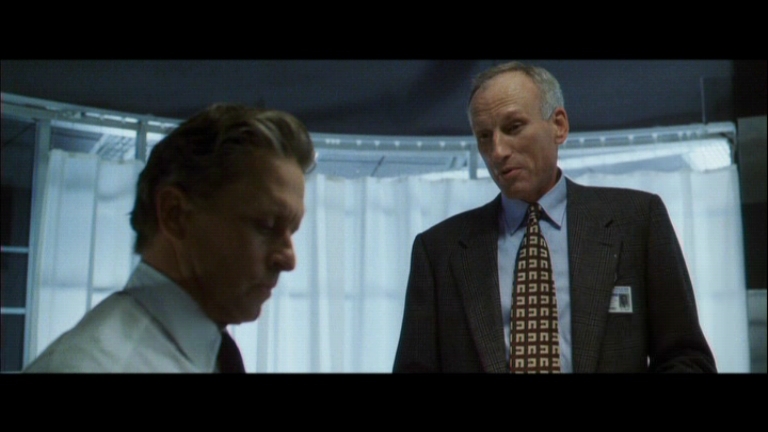 |
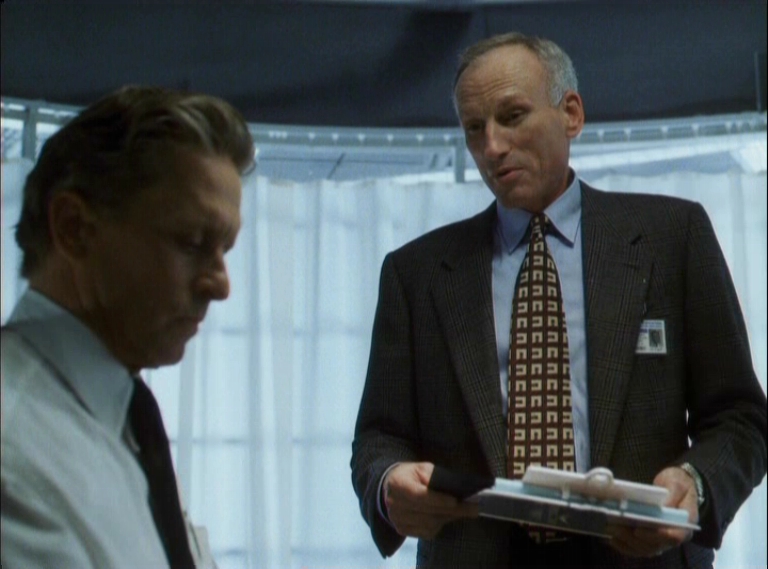 |
|
This is a still from The Game, shot
using the Super 35 process. |
This is the full screen version of The Game.
Note the combination of image characteristics; firstly there is more
image top and bottom of screen, and secondly, there is less information
at the sides of the image. |
There are a number of issues inherent in
Super 35 cinematography and its open matte presentation. Firstly, since almost
half of the original negative image is discarded when producing the theatrical
print, the final resolution of the image is not as good as it would be with the
conventional anamorphic process used for the production of 2.35:1 movies. The
end result can be a very grainy looking theatrical image with poor image
resolution.
There are also issues with the open matte TV
presentation of the movie, more of an issue for special effects extravaganzas
than it is for more straightforward dramatic or comedic movies. Special effects
shots for movies are normally produced at a single aspect ratio, usually the
theatrical aspect ratio. So, special effects shots for 2.35:1 movies are
produced at 2.35:1 - to do otherwise would be a waste of resources and money for
what is already a very expensive process. When it comes time for these shots to
be prepared for display on narrow screens, unlike the conventional Super 35
shots which have additional image top and bottom which can be utilized, there is
no additional image available to show for the special effects shots, so they
need to be Panned & Scanned.
Closing Remarks
We hope that the above discussion of the
processes involved in producing narrow screen versions of widescreen movies will
serve to explain a number of things you may have noticed in your journey through
the widescreen wilderness, such as occasionally noticing less image on
your DVD than on VHS or TV versions of movies. Indeed, often the term
"widescreen presentation" may not be the most correct description for a
transfer, and "original theatrical aspect ratio" would be the more technically
accurate term.
Regardless of all of the above, hopefully we
have shown that these other presentation methods are merely compromises to
accommodate increasingly outdated and disappearing technology (narrow aspect
ratio display devices), and they all compromise the artistic integrity of the
director and cinematographer's vision. We should all be demanding transfers in
the original theatrical aspect ratio, as these are closest to the director's and
cinematographer's visions.
© Michael Demtschyna (read my bio)
March 24, 2005




